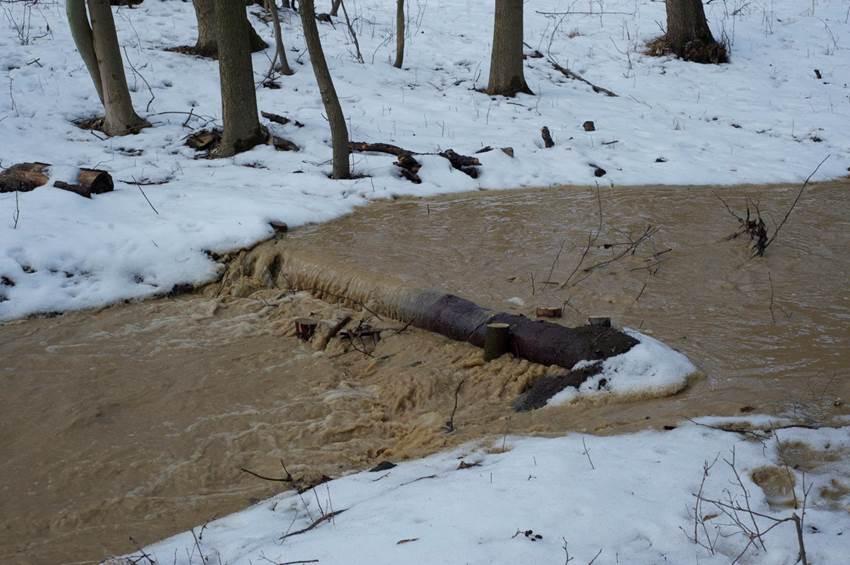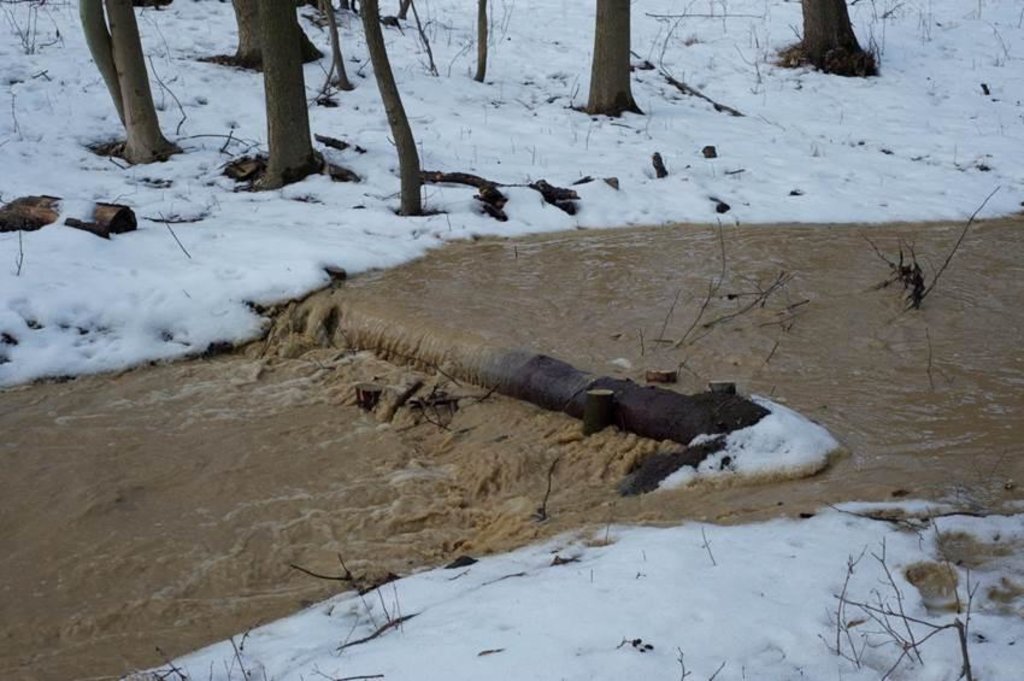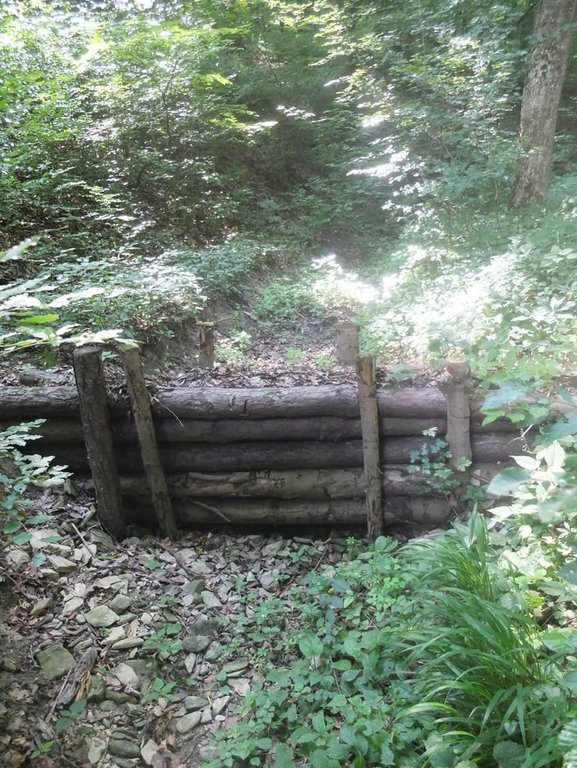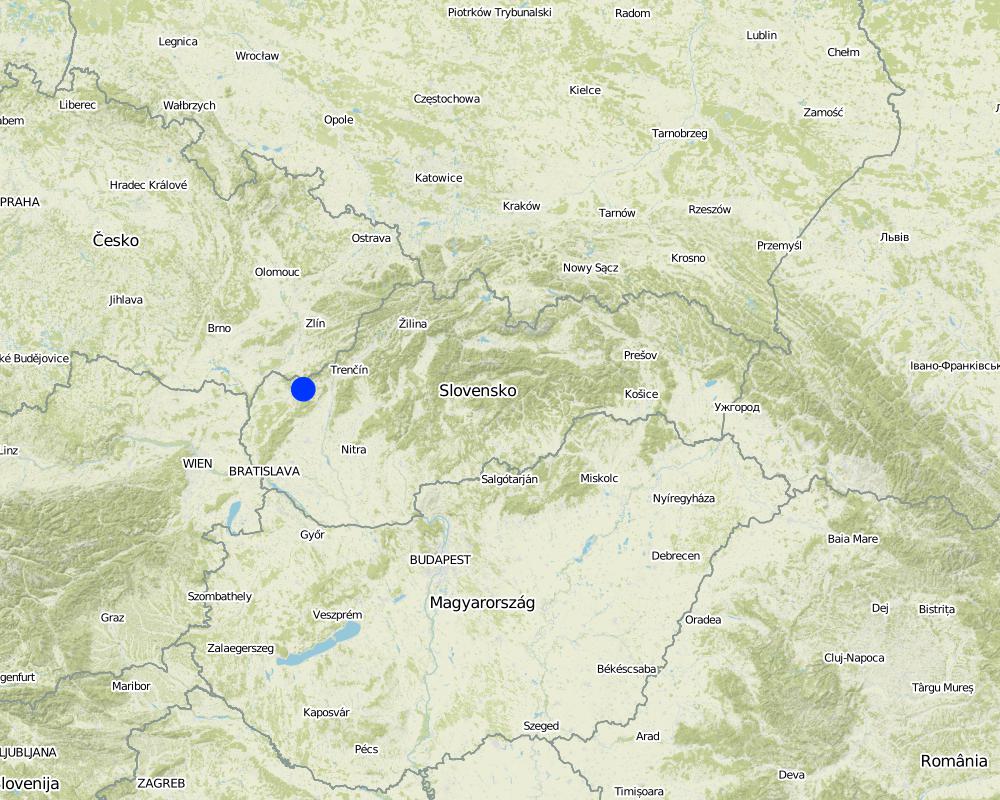Wooden check dams [斯洛伐克]
- 创建:
- 更新:
- 编制者: Zuzana Studvova
- 编辑者: –
- 审查者: Fabian Ottiger, Alexandra Gavilano
Drevené prehrádzky (Slovak language)
technologies_1664 - 斯洛伐克
查看章节
全部展开 全部收起1. 一般信息
1.2 参与该技术评估和文件编制的资源人员和机构的联系方式
有助于对技术进行记录/评估的项目名称(如相关)
Preventing and Remediating degradation of soils in Europe through Land Care (EU-RECARE )有助于对技术进行记录/评估的机构名称(如相关)
Slovak University of Technology (Slovak University of Technology) - 斯洛伐克1.3 关于使用通过WOCAT记录的数据的条件
编制者和关键资源人员接受有关使用通过WOCAT记录数据的条件。:
是
1.5 参考关于SLM方法(使用WOCAT记录的SLM方法)的调查问卷
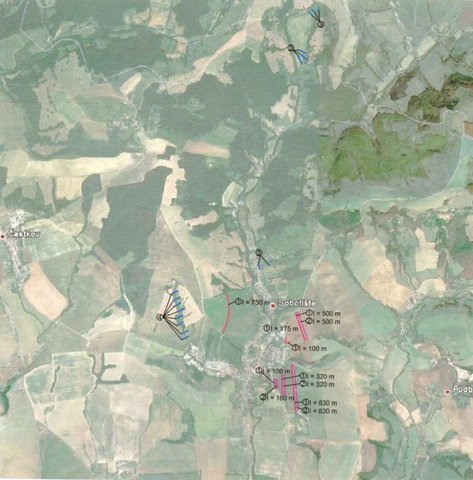
The programme of landscape revitalization and integrated river … [斯洛伐克]
This approach is devoted to the implementation of 'The Landscape Revitalisation Programme and integrated river basins management of the Slovak Republic' in the Sobotište village.
- 编制者: Zuzana Studvova
2. SLM技术的说明
2.1 技术简介
技术定义:
Small wooden check dams built in erosion rills, grooves or gorges to reduce flood risk.
2.2 技术的详细说明
说明:
The terrain is considerably sloping with deep "V" cuts in steep terrain. In that area small check dems, made of wooden logs, were realized..
Purpose of the Technology: The aim was to reduce flood risk mitigation by torrential rains and local flooding.
Natural / human environment: The area is situated in a valley at the foot of the Carpathians, which are part of the outer Carpathian Belt formed by flysch. Relatively large differences in elevation of the country cause excessive concentration of surface runoff. Substantial part of the tributaries are formed by concentrating runoff in ravines, erosion grooves, rills. Most of the country consists of agricultural production of crops, less by forests and grasslands.
2.3 技术照片
2.5 已应用该技术的、本评估所涵盖的国家/地区/地点
国家:
斯洛伐克
区域/州/省:
Slovakia / Myjava
有关地点的进一步说明:
Myjava
注释:
The area of the one small check dam is few squared meters. The technology was used on different places in the area. The area of the city is 4854 ha.
Map
×2.6 实施日期
如果不知道确切的年份,请说明大概的日期:
- 不到10年前(最近)
2.7 技术介绍
详细说明该技术是如何引入的:
- 通过项目/外部干预
3. SLM技术的分类
3.2 应用该技术的当前土地利用类型

农田
- 一年一作
年作 - 具体指明作物:
- 谷物类 - 玉米
- 油料作物 - 向日葵、菜籽、其他
- wheat
每年的生长季节数:
- 1
具体说明:
Longest growing period in days: 180Longest growing period from month to month: April to october

森林/林地
- (半天然)天然森林/林地
(半天然)天然森林/林地:具体说明管理类型:
- 选伐
产品和服务:
- 木材
- 薪材
- 自然保持/保护
- 娱乐/旅游
- 自然灾害防护
注释:
Major cash crop: Oil-seed rape (Brassica napus)
Major food crop: Wheat
Other crops: Maize / corn (Zea mays)
Major land use problems (compiler’s opinion): The main land use problem is steep terrain. During heavy rains runoff forms and floods in the lower part of the area.
Major land use problems (land users’ perception): Steep terrain with influence of heavy mechanisms forms gullies in the forest and causes demages by floods and mud floods.
Selective felling of (semi-) natural forests: Yes
Problems / comments regarding forest use: Unknown
Forest products and services: Primary: Timber, fuelwood, secondary: Recreation / tourism third: protection against natural hazardsnature conservation / protection,
3.4 供水
该技术所应用土地的供水:
- 混合雨水灌溉
3.5 该技术所属的SLM组
- 地表水管理(泉、河、湖、海)
3.6 包含该技术的可持续土地管理措施

结构措施
- S5:大坝、集水斗、水池
注释:
Main measures: structural measures
3.7 该技术强调的主要土地退化类型

土壤水蚀
- Wg:冲沟侵蚀/沟蚀
注释:
Main type of degradation addressed: Wg: gully erosion / gullying
Main causes of degradation: Heavy / extreme rainfall (intensity/amounts)
Secondary causes of degradation: Heavy forest mechanisms (The use of the heavy mechanisms that make cuts (rills) by its wheels in the ground, especially during or after rain. Runoff that forms, flows in rills and deepen those rills.)
3.8 防止、减少或恢复土地退化
具体数量名该技术与土地退化有关的目标:
- 减少土地退化
注释:
Main goals: mitigation / reduction of land degradation
4. 技术规范、实施活动、投入和成本
4.1 该技术的技术图纸
技术规范(与技术图纸相关):
Technical knowledge required for field staff / advisors: low
Technical knowledge required for land users: low
Main technical functions: reduction of slope angle, reduction of slope length
Secondary technical functions: control of concentrated runoff: impede / retard, stabilisation of soil (eg by tree roots against land slides), sediment retention / trapping, sediment harvesting
Dam/ pan/ pond
Vertical interval between structures (m): -
Spacing between structures (m): -
Depth of ditches/pits/dams (m): -
Width of ditches/pits/dams (m): 1 to 5 m
Length of ditches/pits/dams (m): -
Height of bunds/banks/others (m): 2 m
Width of bunds/banks/others (m): -
Length of bunds/banks/others (m): -
Construction material (wood): Wooden round logs (rough strains)(150-180 mm in diameter; 100-500 cm long), wooden stakes.
Specification of dams/ pans/ ponds: Capacity 20.53 to 94.09, together 374m3
4.2 有关投入和成本计算的一般信息
其它/国家货币(具体说明):
Euro
如相关,注明美元与当地货币的汇率(例如1美元=79.9巴西雷亚尔):1美元=:
0.89
4.3 技术建立活动
| 活动 | 时间(季度) | |
|---|---|---|
| 1. | Wooden structure instalation | november, december |
4.4 技术建立所需要的费用和投入
| 对投入进行具体说明 | 单位 | 数量 | 单位成本 | 每项投入的总成本 | 土地使用者承担的成本% | |
|---|---|---|---|---|---|---|
| 劳动力 | Labour | Dam | 1.0 | 238.0 | 238.0 | |
| 设备 | Tools | Dam | 1.0 | 182.0 | 182.0 | |
| 施工材料 | Wood | Dam | 1.0 | 626.0 | 626.0 | |
| 技术建立所需总成本 | 1046.0 | |||||
| 技术建立总成本,美元 | 1175.28 | |||||
注释:
Duration of establishment phase: 0.1 month(s)
4.6 维护/经常性活动所需要的费用和投入(每年)
注释:
Machinery/ tools: chainsaw, handsaw, heavy hammer, shovels, spades, hoes, pickaxes, ax
The costs are calculated (averaged) for one dam. Together 6 wooden dams were built on the study area - 90 ha. The costs were valid for the year 2011. The prices were calculated with the 20% VAT.
4.7 影响成本的最重要因素
描述影响成本的最决定性因素:
Material and labour price.
5. 自然和人文环境
5.1 气候
年降雨量
- < 250毫米
- 251-500毫米
- 501-750毫米
- 751-1,000毫米
- 1,001-1,500毫米
- 1,501-2,000毫米
- 2,001-3,000毫米
- 3,001-4,000毫米
- > 4,000毫米
有关降雨的规范/注释:
93 -100 rainy days/year,
农业气候带
- 半干旱
- 干旱
Thermal climate class: temperate
5.2 地形
平均坡度:
- 水平(0-2%)
- 缓降(3-5%)
- 平缓(6-10%)
- 滚坡(11-15%)
- 崎岖(16-30%)
- 陡峭(31-60%)
- 非常陡峭(>60%)
地形:
- 高原/平原
- 山脊
- 山坡
- 山地斜坡
- 麓坡
- 谷底
垂直分布带:
- 0-100 m a.s.l.
- 101-500 m a.s.l.
- 501-1,000 m a.s.l.
- 1,001-1,500 m a.s.l.
- 1,501-2,000 m a.s.l.
- 2,001-2,500 m a.s.l.
- 2,501-3,000 m a.s.l.
- 3,001-4,000 m a.s.l.
- > 4,000 m a.s.l.
5.3 土壤
平均土层深度:
- 非常浅(0-20厘米)
- 浅(21-50厘米)
- 中等深度(51-80厘米)
- 深(81-120厘米)
- 非常深(> 120厘米)
土壤质地(表土):
- 粗粒/轻(砂质)
如有可能,附上完整的土壤描述或具体说明可用的信息,例如土壤类型、土壤酸碱度、阳离子交换能力、氮、盐度等。:
Soil fertility is medium
Topsoil organic matter is unknown
Soil drainage/infiltration is good
Soil water storage capacity is unknown
5.4 水资源可用性和质量
地表水的可用性:
好
水质(未处理):
良好饮用水
关于水质和水量的注释和进一步规范:
Ground water table is unknown
Water quality (untreated) is good drinking water (ground water)
5.5 生物多样性
物种多样性:
- 中等
5.6 应用该技术的土地使用者的特征
生产系统的市场定位:
- 混合(生计/商业)
- 商业/市场
相对财富水平:
- 平均水平
个人或集体:
- 团体/社区
机械化水平:
- 机械化/电动
性别:
- 男人
说明土地使用者的其他有关特征:
Land users applying the Technology are mainly common / average land users
Population density: 50-100 persons/km2
Annual population growth: negative; 4%
Off-farm income specification: Unknown
5.7 应用该技术的土地使用者使用的平均土地面积
- < 0.5 公顷
- 0.5-1 公顷
- 1-2 公顷
- 2-5公顷
- 5-15公顷
- 15-50公顷
- 50-100公顷
- 100-500公顷
- 500-1,000公顷
- 1,000-10,000公顷
- > 10,000公顷
这被认为是小规模、中规模还是大规模的(参照当地实际情况)?:
- 中等规模的
注释:
1-2 ha: 1036 ha of forest. Population is 11740. Number of households is unknown.
5.8 土地所有权、土地使用权和水使用权
土地所有权:
- 社区/村庄
- 个人,未命名
土地使用权:
- 租赁
用水权:
- 租赁
5.9 进入服务和基础设施的通道
健康:
- 贫瘠
- 适度的
- 好
教育:
- 贫瘠
- 适度的
- 好
技术援助:
- 贫瘠
- 适度的
- 好
就业(例如非农):
- 贫瘠
- 适度的
- 好
市场:
- 贫瘠
- 适度的
- 好
能源:
- 贫瘠
- 适度的
- 好
道路和交通:
- 贫瘠
- 适度的
- 好
饮用水和卫生设施:
- 贫瘠
- 适度的
- 好
金融服务:
- 贫瘠
- 适度的
- 好
6. 影响和结论性说明
6.1 该技术的现场影响
社会经济效应
其它社会经济效应
Damage
注释/具体说明:
Less demage on properties because of flooding and mud floods.
生态影响
其它生态影响
Speed of runoff
注释/具体说明:
Retard/slow down runoff
6.2 该技术的场外影响已经显现
对公共/私人基础设施的破坏
6.3 技术对渐变气候以及与气候相关的极端情况/灾害的暴露和敏感性(土地使用者认为的极端情况/灾害)
渐变气候
渐变气候
| 季节 | 增加或减少 | 该技术是如何应对的? | |
|---|---|---|---|
| 年温度 | 增加 | 好 |
气候有关的极端情况(灾害)
气象灾害
| 该技术是如何应对的? | |
|---|---|
| 局地暴雨 | 不好 |
水文灾害
| 该技术是如何应对的? | |
|---|---|
| 比较和缓的(河道)洪水 | 不好 |
6.4 成本效益分析
技术收益与技术建立成本相比如何(从土地使用者的角度看)?
短期回报:
稍微积极
长期回报:
非常消极
技术收益与技术维护成本/经常性成本相比如何(从土地使用者的角度看)?
短期回报:
稍微积极
长期回报:
非常消极
注释:
The life of the structur, as it is made of wood is not very long. It is sedimated signifitantly afterheavy rains.
6.7 该技术的优点/长处/机会
| 编制者或其他关键资源人员认为的长处/优势/机会 |
|---|
| The technology is easy to built and maintain. |
| Simple tools and equipment needed. |
| Low number of labour. |
6.8 技术的弱点/缺点/风险及其克服方法
| 编制者或其他关键资源人员认为的弱点/缺点/风险 | 如何克服它们? |
|---|---|
| Relative short duration. | |
| Maintanance needed. | |
| Ineffective during extremly high storms and it can be damaged. |
7. 参考和链接
7.1 信息的方法/来源
7.3 链接到网络上的相关信息
标题/说明:
http://www.hospodarskyklub.sk/docs/katalog2.pdf
链接和模块
全部展开 全部收起链接

The programme of landscape revitalization and integrated river … [斯洛伐克]
This approach is devoted to the implementation of 'The Landscape Revitalisation Programme and integrated river basins management of the Slovak Republic' in the Sobotište village.
- 编制者: Zuzana Studvova
模块
无模块


